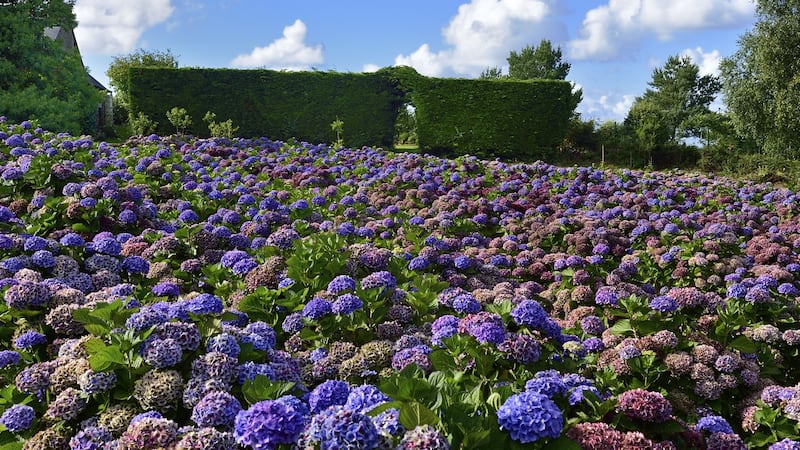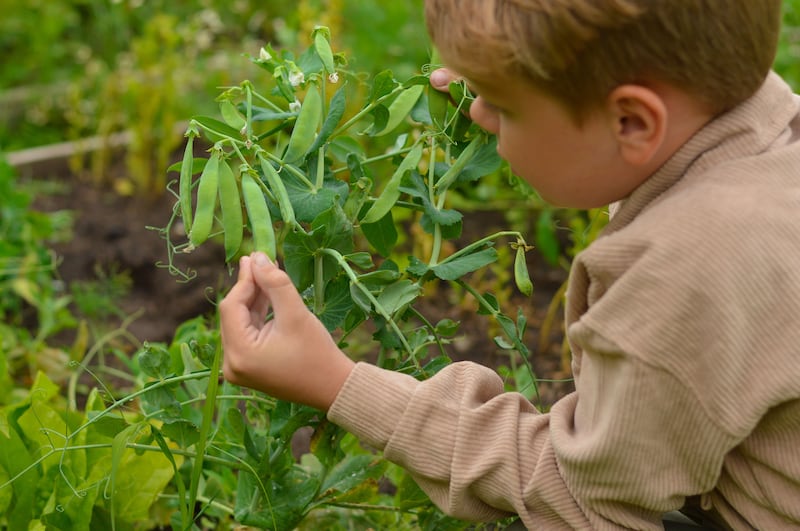I sometimes wonder which memories of the gardens of their childhood my young sons will take with them into their old age.
Will they, for example, remember the beech trees that flank the edges of their grandparents’ country garden, through whose tall branches the evening sunlight flickers on a summer’s day like old cine film? Or the raspberry patch they looted as small children, swatting away the sugar-drunk wasps that hovered. Will they slowly forget the new-born-seedlings mugginess of the glasshouse in spring, and the lilac in its perfumed late spring bloom, or the whiff of damp earth that filled the air one searingly hot summer’s day, when rain finally fell in giant, heavy drops on a dusty, drought-hit lawn.
Alternatively, might they, even with the long passage of time, always hold some sort of imprinted memory of their very first miraculous sniff of a garden rose. Of watching wild bees industriously clamber their way into the hooded flowers of a foxglove. Of the greedy joy of prising home-grown garden peas from their velvet-soft green pods, to feast on as a summer snack.
I hope so.
READ MORE
My own enduring early memories of long-ago gardens are like faded photographs that have blurred with age. I remember with a very small child’s perspective, for example, the low, long plastic cloche that my mother once erected in the back garden to grow heat-loving vegetables, such as French beans, cucumber and tomatoes, through which I loved to slowly crawl, caterpillar-like, to marvel at the tropical otherworldliness of it. Similarly in my mind’s eye, I can still see the buddleia bush that in late summer became magically alive with clouds of butterflies- tortoiseshells, peacocks, red admirals- incapable of resisting the sweet lure of its nectar-rich purple flower spikes. I’ve also never forgotten the very first flowers I grew from seed- a fiery, explosion of orange nasturtiums- as well as the lupins I nurtured as a teenager, whose plump, tall flower spikes I celebrated with a sense of reverence.
Back then, I may not have known their names, but now I recognise that sprawling yellow spring-flowering shrub from my childhood as forsythia, and that silver-grey leaved aromatic perennial that our genial ginger tomcat liked to sunbathe on as catmint. The same goes for the very old, white-flowered variety of border phlox that came from my godmother’s childhood garden, whose perfumed, starry blooms drew fluttering moths on summer evenings. And the silver tangle of snow-in-summer that grew in a large and unruly carpet beneath the kitchen window until suddenly, after one exceptionally harsh winter, it didn’t.
[ From seed to perfect plants and veg: tips to guarantee a bountiful gardenOpens in new window ]

My childhood family garden aside, I have childhood memories of other gardens and plants. Of a summer holiday by the seaside, where fat hydrangeas bloomed in electric shades of scarlet and violet-blue, and of a walled garden filled with hollyhocks. Of a country courtyard garden, where climbing roses covered its stone walls in giant swathes, and another filled with bluebells.
Plants, it turns out, have been intriguing me since I was tiny, becoming as much a part of my interior landscape as people. Many of my most vivid memories of them are also inextricably linked to memories of the gardens in which they once grew, and of the gardeners who tended them. For this reason, they remain like doorways into the past, potent living reminders of other times and other places.
This, of course, is one of their many beguiling qualities. It’s why we bring certain much-loved plants with us when we move house and why we take cuttings/ divisions/seedlings of favourite plants from the gardens of much-loved family members and friends. It’s why we like to commemorate births, deaths, marriages and other significant occasions in our lives by planting a shrub, tree or rose bush, and why we’ll go to great lengths to track down old favourites that we associate strongly with a significant person, place or time in our life.
[ Your gardening questions answered: Can I plant lilac now?Opens in new window ]
Likewise, it’s why so many plants are named after important events in human history or after notable or famous people, especially gardeners. Examples include the best-selling Rosa ‘Peace’ named in celebration of the end of WW2 and Rosa ‘Gertrude Jekyll’ named after the great English gardener; as well as the fern known as Gaga marginalis named after the American singer songwriter-actress Lady Gaga; the tropical tree, Uvariopsis dicaprio, named after the actor Leonardo DiCaprio; and Genlisea hawkingii, a carnivorous plant from Brazil named after the British scientist Stephen Hawking. It’s also why we so often informally christen the plants that grow in our gardens in memory of those important people in our lives with whom we deeply associate them; ‘Aunt Mary’s rose’, for example, or ‘Grandad’s rhubarb’.
True, not all plant names that commemorate notable people have stood the test of time, whether because they’ve subsequently achieved a level of infamy rather than fame, or are names that have become negatively associated with the colonial ways of faded empires.
But a wealth of plant names remain to serve as enduring cultural and personal links, forming a rich horticultural tapestry that stretches around the world to connect us to other gardeners as well as to loved ones past and present.

Not just past and present. Like time-travellers, the plants that grow in our gardens also connect us to loved ones of the future, as well as to our own future selves. It’s why earlier this month, as I planted snowdrops, fritillaries, hellebores and dwarf daffodils under the dappled deciduous shade of the two old beech trees in my own garden, I thought of how they might look in the years to come as they slowly spread and multiplied. Of the pleasure that they would hopefully give to me and others. Of how my young sons might look at them one distant day in the faraway future, and feel that sudden jolt of joy that all gardeners know and love. Of how that love of nature will fortify them throughout their lives. Perhaps they too will plant flowers in their own gardens one bright spring day, and dream about the future.
I hope so.
This week in the garden
This is an excellent time of the year to take basal cuttings of many kinds of herbaceous plants, which are busily pushing their new, fleshy shoots through the soil such as delphiniums, lupins and campanulas. Use a sharp, clean knife to do this, choosing strong non-hollow shoots roughly 10cm long and cutting them away close to the crown of the plant. These shoots are naturally very rich in growth hormones, so there’s no need to use hormone powder. Simply place them up to their waist around the edges of a pot filled with a 50:50 mix of seed compost and horticultural grit, water well, label, cover with an upturned clear freezer bag sealed with an elastic band and then place the pot on a bright windowsill (but out of direct sunshine) or a heated propagator to encourage swift root development.
As another new growing season kicks off, don’t forget that houseplants also respond to the increase in natural light levels by bursting into new growth with a consequent increase in their need for water. This is also a good time of the year to give them a tidy-up by removing any dead or dying leaves. A 2cm-3cm top-dressing of fresh compost, after first gently scratching away the old top layer is also a good idea, while any houseplants showing signs of being top bound should be potted on into a larger container using fresh compost.
Dates for your diary
Easter Sunday, March 31st -Easter Monday, April 1st (10am-5pm), the first ISNA Plant Fair of 2024 takes place at Farmleigh House, Phoenix Park, Dublin 1, see farmleigh.ie and irishspecialistnurseriesassociation.com
Saturday April 20th- Sunday April 21st, the inaugural Festival of Gardens and Nature takes place at Ballintubbert House & Gardens, Stradbally, Co Laois, with a wonderful line up of expert speakers from Ireland, the UK and the US covering a diverse range of topics from kitchen gardening, scented gardens, soil health and sustainable floristry to revitalising historic gardens, supporting garden biodiversity and rewilding. Speakers include perfumers Sadie Chowen of the Burren Perfumery and Cath Kidston, florists and sustainability champions Shane Connolly, Emily Thompson and the Land Gardeners Brigitte Elsworth & Henrietta Courtauld, actor Dominic West, Irish gardeners and authors Jimi Blake, Colm O’Driscoll, Seamus O’Brien and TJ Maher and the natural swimming pool designer David Pagan Butler, plus many more (see festivalofgardensandnature.com to book tickets);
June Blake’s Garden & Nursery, Tinode, Blessington, Co Wicklow reopens to the public from Sunday, April 7th, with a glorious display of spring-flowering woodland plants (Thursdays-Sundays, 11am-5pm), see juneblake.ie
- Listen to our Inside Politics Podcast for the latest analysis and chat
- Sign up for push alerts and have the best news, analysis and comment delivered directly to your phone
- Find The Irish Times on WhatsApp and stay up to date
















